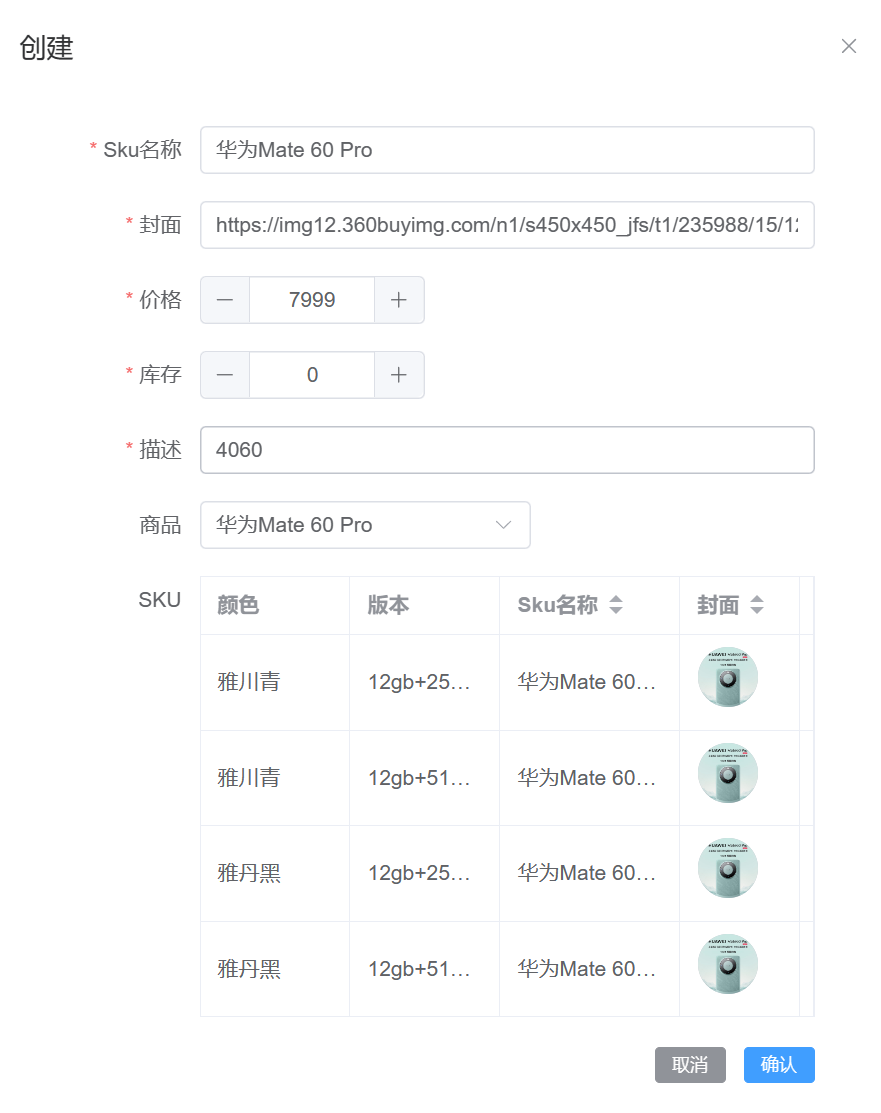商品SKU
大约 5 分钟
商品SKU

建表
-- auto-generated definition
create table product_sku
(
id varchar(36) not null
primary key,
created_time datetime(6) not null,
edited_time datetime(6) not null,
creator_id varchar(36) not null,
editor_id varchar(36) not null,
`values` varchar(255) not null,
name varchar(255) not null,
product_id varchar(255) not null,
cover varchar(255) null,
price decimal(38, 2) null,
stock int null,
description varchar(255) null
);
实体类
@GenEntity
@Entity
public interface ProductSku extends BaseEntity {
@Column(name = "`values`")
@Key
@Serialized
List<String> values();
@GenField(value = "Sku名称", order = 0)
String name();
@ManyToOne
@OnDissociate(DissociateAction.DELETE)
@Key
Product product();
@IdView
@GenField(value = "商品", order = 1)
String productId();
@GenField(value = "封面", type = ItemType.PICTURE, order = 2)
String cover();
@NotNull
@GenField(value = "价格", type = ItemType.INPUT_NUMBER, order = 3)
BigDecimal price();
@GenField(value = "库存", order = 4)
int stock();
@GenField(value = "描述", order = 5)
String description();
}
生成代码
参考开发流程
关联商品
修改Dto
ProductSku.dto
input ProductSkuInput {
#allScalars(ProductSku)
productId
id?
}
商品查询
product-store.ts
export const productQueryOption = async (keyword: string, id: string) => {
return (
await api.productController.query({
body: { query: { name: keyword, id } }
})
).content
}
商品选择
<el-form-item label="商品" prop="product">
<remote-select
label-prop="name"
:query-options="productQueryOption"
:model-value="createForm.productId"
@update:model-value="handleProductChange"
></remote-select>
</el-form-item>
复用商品信息
商品sku的默认值可以用关联的商品信息填写. 选择完商品后得到商品的id,请求数据得到商品信息. 将商品信息复制给sku创建表单
const handleProductChange = (id: string) => {
api.productController.findById({ id }).then((res) => {
createForm.value = {
...createForm.value,
..._.pick(res, ['price', 'cover', 'name', 'description'])
}
createForm.value.productId = id
})
}
sku创建
sku的生成是基于商品的属性进行排列组合生成的. 如手机sku, (黑色, 8gb+256gb),(白色, 8gb+256gb), (黑色, 12gb+512gb), (白色, 12gb+512gb).
存储商品属性
const attributes = ref<KeyValue[]>([])
const skuList = ref<ProductSkuInput[]>([])
const handleProductChange = (id: string) => {
api.productController.findById({ id }).then((res) => {
attributes.value = res.attributes
// 忽略...
})
}
生成sku
product-sku-create-table.vue
<script lang="ts" setup>
import { computed, watch } from 'vue'
import type { KeyValue, ProductSkuInput } from '@/apis/__generated/model/static'
import type { Scope } from '@/typings'
import _ from 'lodash'
type ProductSku = ProductSkuInput & {
[index: string]: string | string[] | number
}
type ProductSkuScope = Scope<ProductSku>
const props = withDefaults(
defineProps<{
attributes: KeyValue[]
skuList: ProductSkuInput[]
}>(),
{
attributes: () => {
return []
},
skuList: () => {
return []
}
}
)
const emit = defineEmits<{ 'update:skuList': [skuList: ProductSku[]] }>()
const initSku: ProductSku = {
productId: '',
cover: '',
description: '',
name: '',
price: 0,
stock: 0,
values: []
}
// 递归排列组合
const deep = (sku: ProductSku, depth: number, attrList: KeyValue[]) => {
const list: ProductSku[] = []
if (attrList.length === 0) {
return []
}
if (depth === attrList.length) {
return [_.cloneDeep(sku)]
}
const attribute = attrList[depth]
if (attribute.values.length === 0) return []
// 获取每个属性的值(选择的),将各个属性的值进行组合
const attrValues = attribute.values
attrValues.forEach((value) => {
// sku对象新增字段,字段的名字是属性的名字。比如 {"糖份":"多糖"}
sku[attribute.name] = value
// 加入当前属性的参数
sku.values.push(value)
// 获取下一个属性的参数
list.push(...deep(sku, depth + 1, attrList))
// 弹出当前属性的参数,准备加入当前属性的下一个参数
sku.values.pop()
})
return list
}
// 计算函数,将下面的sku格式转成前端的表格读取格式。
// [{"values": ["黑色", "8gb+256"]},{"values": ["白色", "8gb+256"]}]
// -> [{"颜色": "黑色", "型号": "8gb+256"},{"颜色": "白色", "型号": "8gb+256"}]
const skuArray = computed(() => {
return props.skuList.map((sku) => {
const row: ProductSku = { ...sku }
// attributes=[{"name" :"颜色", "values": ["黑色", "白色"]}, {"name" : "型号", "values": ["8gb+256", "128gb"]}]
// 可以看到sku中values各个值的索引在attributes中可以对应属性名称。如 黑色(0) 用0在attributes中找到对应属性名称即"颜色"。
sku.values.forEach((attrValue, index) => {
row[props.attributes[index].name] = attrValue
})
return row
})
})
watch(
() => props.attributes,
(value, oldValue) => {
// 第一次加载时使用默认的skuList不需要重新生成
if (oldValue.length === 0 && props.skuList.length > 0) {
return
}
const skuList = deep({ ...initSku }, 0, props.attributes)
console.log(skuList)
// 当属性修改时重新生成skuList
emit('update:skuList', skuList)
},
{ deep: true }
)
</script>
<template>
<el-table ref="table" :data="skuArray" :border="true">
<el-table-column
v-for="attribute in attributes"
:key="attribute.name"
:prop="attribute.name"
:label="attribute.name"
minWidth="100"
show-overflow-tooltip
>
</el-table-column>
<el-table-column
label="Sku名称"
prop="name"
sortable="custom"
min-width="120"
show-overflow-tooltip
>
<template v-slot:default="{ row }: ProductSkuScope">
{{ row.name }}
</template>
</el-table-column>
<el-table-column label="封面" prop="cover" sortable="custom" min-width="80">
<template v-slot:default="{ row }: ProductSkuScope">
<ElAvatar :src="row.cover"></ElAvatar>
</template>
</el-table-column>
<el-table-column
label="价格"
prop="price"
sortable="custom"
min-width="80"
show-overflow-tooltip
>
<template v-slot:default="{ row }: ProductSkuScope">
{{ row.price }}
</template>
</el-table-column>
<el-table-column
label="库存"
prop="stock"
sortable="custom"
min-width="80"
show-overflow-tooltip
>
<template v-slot:default="{ row }: ProductSkuScope">
{{ row.stock }}
</template>
</el-table-column>
<el-table-column
label="描述"
prop="description"
sortable="custom"
min-width="120"
show-overflow-tooltip
>
<template v-slot:default="{ row }: ProductSkuScope">
{{ row.description }}
</template>
</el-table-column>
</el-table>
</template>
<style lang="scss" scoped>
.create-form {
margin-right: 30px;
}
</style>
初始化sku信息
如果用户编辑了sku表单,则把表单中的信息赋值给skuList
watch(
() => createForm.value,
() => {
skuList.value = skuList.value.map((sku) => {
return { ...sku, ...createForm.value, values: sku.values }
})
},
{
deep: true
}
)
sku是在用户选择关联的商品之后才会出现的, attributes赋值完之后会生成skuList. nextTick就是等待页面渲染完成之后再执行,这样可以保证skuList已经生成了, createFrom复用product的基础信息, 上面的watch又会更新skuList.
const handleProductChange = (id: string) => {
api.productController.findById({ id }).then((res) => {
attributes.value = res.attributes
nextTick(() => {
createForm.value = {
...createForm.value,
..._.pick(res, ['price', 'cover', 'name', 'description'])
}
createForm.value.productId = id
})
})
}
批量创建sku
ProductSkuController
@PostMapping("save-batch")
public Boolean saveBatch(@RequestBody List<ProductSkuInput> productSkus) {
productSkus.forEach(productSkuService::save);
return true;
}
调用接口批量新增skuproduct-sku-create-form
const handleConfirm = () => {
createFormRef.value?.validate(
assertFormValidate(() =>
api.productSkuController.saveBatch({ body: skuList.value }).then(async (res) => {
assertSuccess(res).then(() => {
closeDialog()
reloadTableData()
})
})
)
)
}
组合值查询条件
修改dto
specification ProductSkuSpec {
#allScalars
like/i(name)
like/i(description)
like/i(cover)
like/i(id)
// 新增查询字段
valueStr: String?
ge(editedTime)
le(editedTime)
ge(createdTime)
le(createdTime)
}
模糊查询
jimmer中提供的查询条件满不足不了需求, 下面可以自定sql动态拼接到where中. values字段在实体类中是List<String>, 在数据库是varchar. jimmer不支持对List<String>like查询, 但是在数据库层面是可以的, 因此这种情况我们直接拼接原生sql进行查询.
ProductSkuRepository
.whereIf(StringUtils.hasText(query.getValueStr()),
Predicate.sql("%e like %v", it -> {
it.expression(productSkuTable.values())
.value("%" + query.getValueStr() + "%");
}))
查询项
product-sku-query
<el-form-item label="属性组合值">
<el-input v-model="query.valueStr"></el-input>
</el-form-item>
